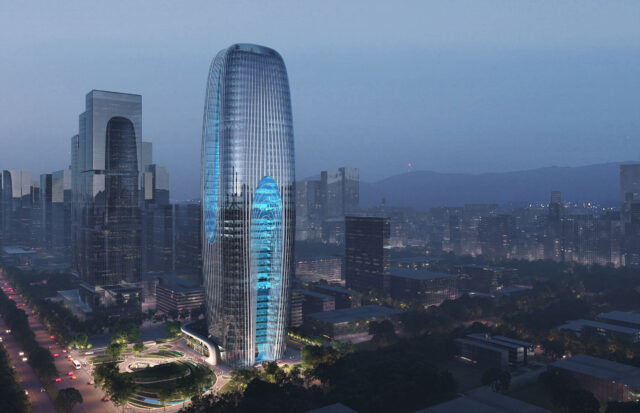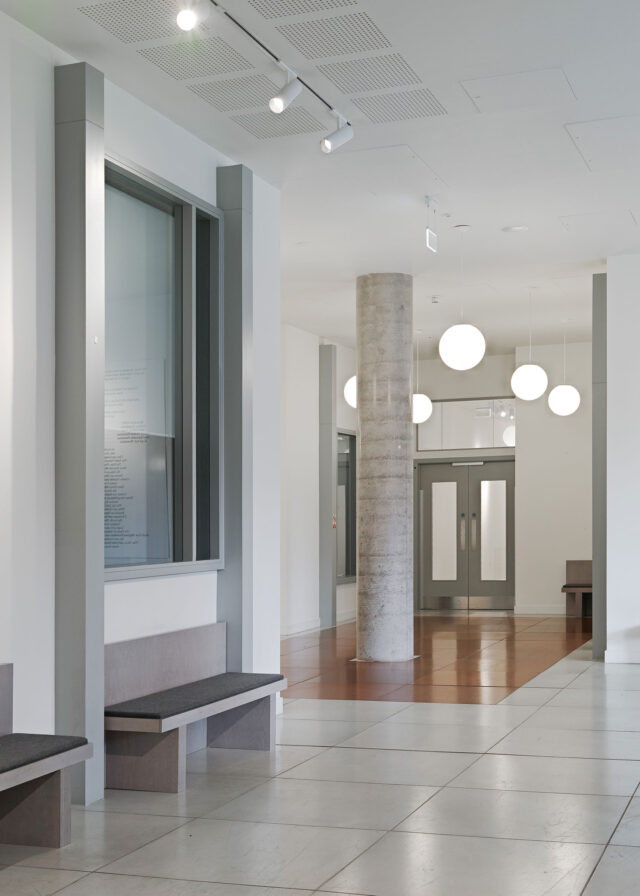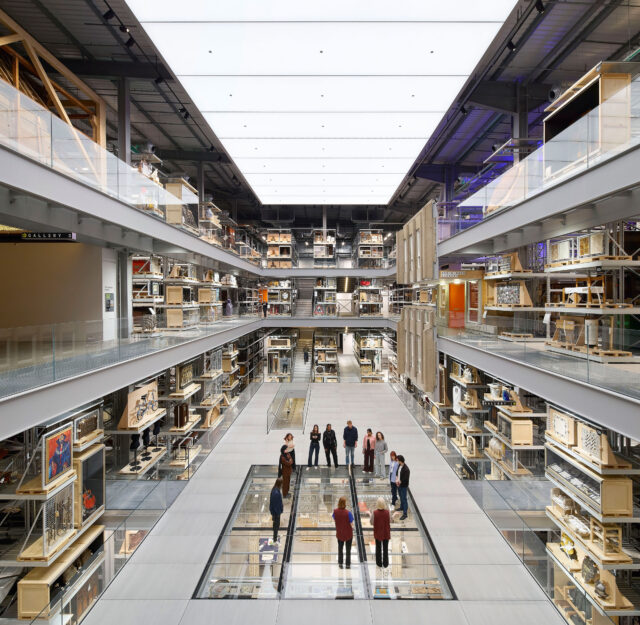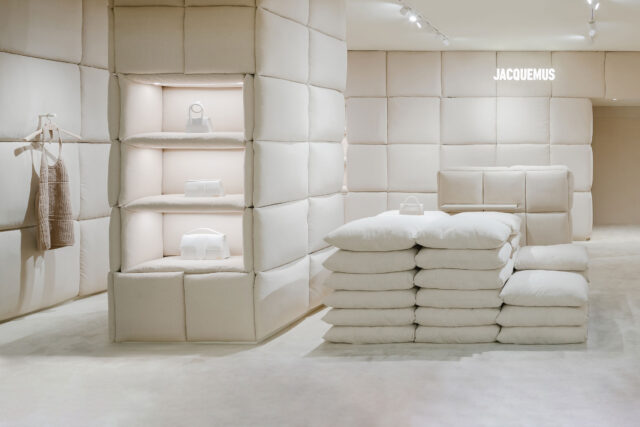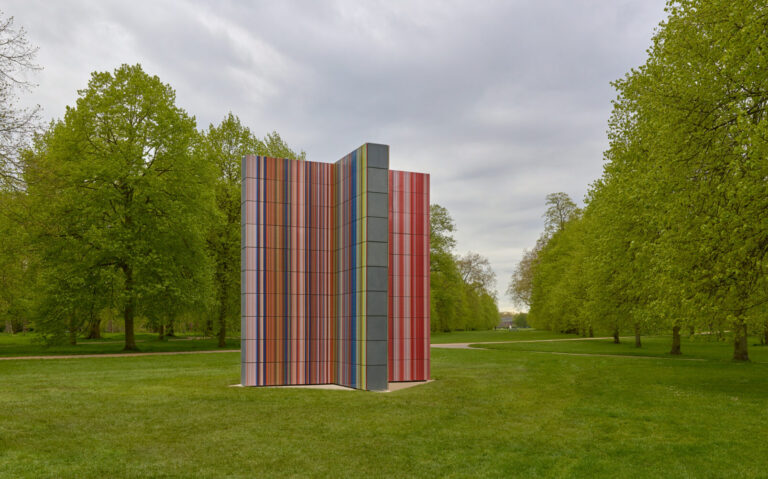
SHARE ゲルハルト・リヒターによる彫刻作品「STRIP-TOWER」。自身の“ストリップ・ペインティング”の手法を用いて制作。ロンドンのケンジントン・ガーデンズで期間限定で公開



ゲルハルト・リヒターによる彫刻作品「STRIP-TOWER」です。
ロンドンのケンジントン・ガーデンズで期間限定で公開されています。会期は2024年10月27日まで。
こちらはプレスリリースの抄訳です
サーペンタインと英国王立公園は、ドイツ人アーティスト、ゲルハルト・リヒター(1932年ドイツ・ドレスデン生まれ、ケルン在住)の大型彫刻作品を発表しました。作品名は、「STRIP-TOWER」(2023年)で、ケンジントン・ガーデンズのサーペンタイン・サウスの台座に設置ました。この作品は、1970年にサーペンタインが設立されて以来、英国王立公園で長年続けられてきた公開プレゼンテーションの最新作です。
「STRIP-TOWER」は、リヒターが60年以上にわたって実践してきた絵画、写真、デジタル複製、抽象の探求と自己探求のアプローチを発展させたものです。
リヒターは2010年に「Abstract Painting 724-4」(1990)と題された以前の「スキージー・ペインティング」に触発され、「ストリップ・ペインティング」シリーズの制作を開始しました。この絵画は写真に撮られ、ソフトウェア・プログラムのサポートにより、スキャンされデジタル処理され、2つ、4つ、8つ、16つ、32の短冊に分割されました。そして、絵画の縦縞を水平に伸ばした後、アルミニウムにラミネートし、パースピレックスで覆うというものです。「STRIP-TOWER」も同様の手法で、カラフルなストライプのセラミック・タイルが2枚の垂直なパネルを覆っています。垂直の細いストライプが緻密な構図を形成し、パネルが交差することで、来場者もその中に立つことができる断面が生まれています。
以下の写真はクリックで拡大します




以下、リリーステキストです。
Serpentine and The Royal Parks are delighted to announce the unveiling of a new large-scale sculpture by German artist Gerhard Richter (b. 1932, Dresden, Germany; lives and works in Cologne, Germany). Situated on the plinth at Serpentine South, in Kensington Gardens, STRIP-TOWER (2023) will be staged from 25 April to 27 October 2024. It will be the latest presentation in a long-standing series of remarkable public presentations in The Royal Parks since Serpentine’s foundation in 1970.
STRIP-TOWER (2023) expands on the artist’s continued exploration of painting, photography, digital reproduction and abstraction and self-scrutinising approach that have occupied his practice for over six decades.
Richter began developing his series of Strip Paintings in 2010, inspired by an earlier ‘squeegee painting’ titled Abstract Painting 724-4 (1990). This painting was then photographed. With the support of a software programme, the scanned images were digitally manipulated and divided into two strips, then four, eight, sixteen and thirty-two. The vertical strips of the painting were then stretched across a horizontal expanse before being laminated onto aluminum and covered with Perspex. STRIP-TOWER employs a similar method, in which colourful striped ceramic tiles clad two perpendicular panels. The thin vertical stripes form a dense composition where the intersecting panels create a cross section that visitors can also stand within.
Gerhard Richter’s artist book Pattern was the first manifestation of this fractal method. It is co published by HENI and Verlag der Buchhandlung Walther und Franz König, Köln and is entirely designed by the artist. The book shows Richter’s experiment of taking an image of his Abstract Painting [CR: 724-4] and dividing it vertically up to 4096 strips. This methodology led to 8190 thinner strips which are then mirrored and repeated. The outcome is 221 patterns which are published on 246 double page images. Pattern is one of many outstanding artist books Richter has produced over the last couple of years such as Wald (Forest) (2008) and EIS (2011), which includes a special layout of the artists stunning photographs of a trip to the Antarctic.
STRIP TOWER builds on Richter’s ongoing interest in the idea of reflections, systems, and repetitions, which could be seen in 4900 Colours exhibited at Serpentine in 2008, with the surfaces of the glossy tiles subtly mirroring the viewer and the surroundings of the Royal Parks.
4900 Colours comprised bright monochrome squares randomly arranged in a grid formation to create stunning sheets of kaleidoscopic colour. The 196 square panels of 25 coloured squares was conceived to be configured in a number of variations, from one large-scale piece to multiple, smaller paintings. Richter developed a version comprised of 49 paintings especially for Serpentine.
4900 Colours in part grew out of Richter’s design for the south transept window of Cologne Cathedral, which replaced the stained glass that had been destroyed during the Second World War. The window, unveiled in August 2007, comprised 11,500 hand-blown squares of glass in 72 colours derived from the palette of the original Medieval glazing. The seemingly arbitrary distribution of colours was generated using a specially developed computer programme. This interest in using chance to define composition was significant in the development of the artist’s concept for 4900 Colours.
STRIP TOWER also continues the artist’s Grid series in 1966 exploring connections with controlled change initiated with the six large, square paintings Cage (1) – (6), (2006). Here, Richter intends to eradicate hierarchy of subjects.

